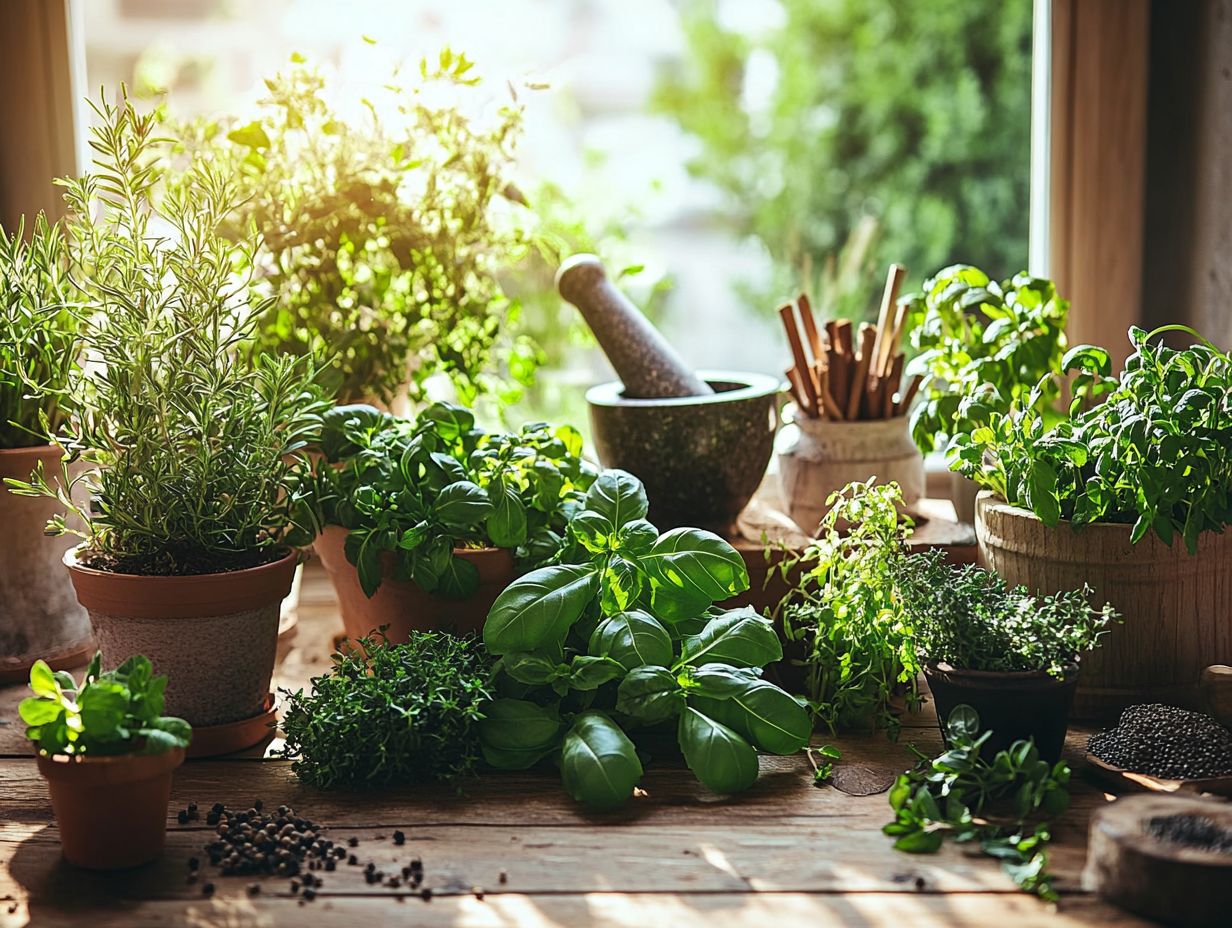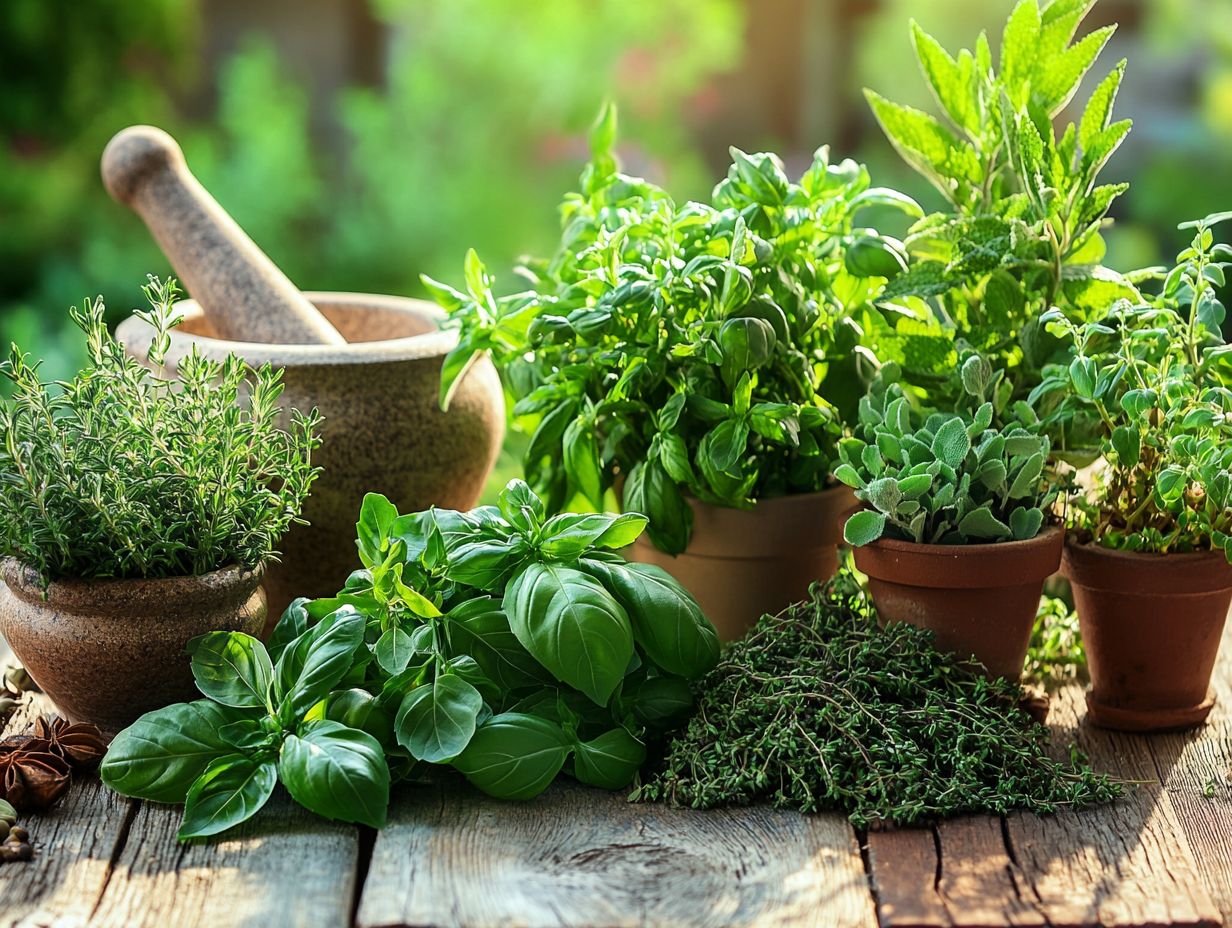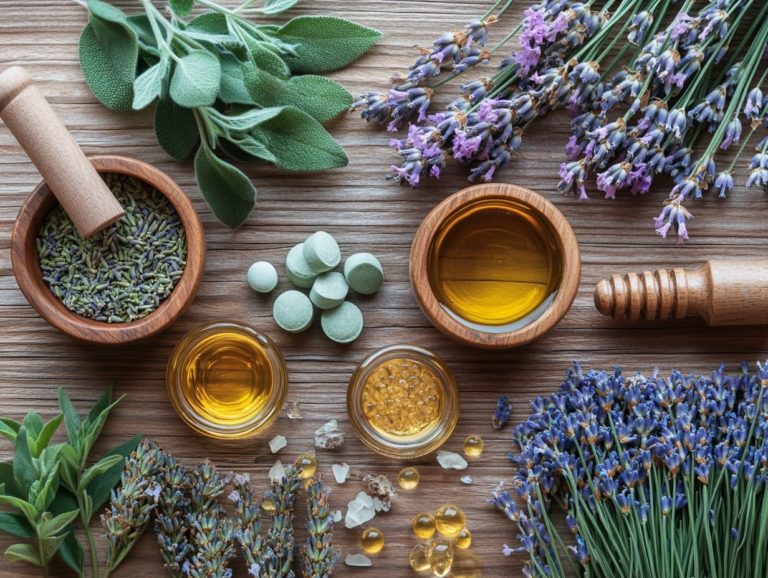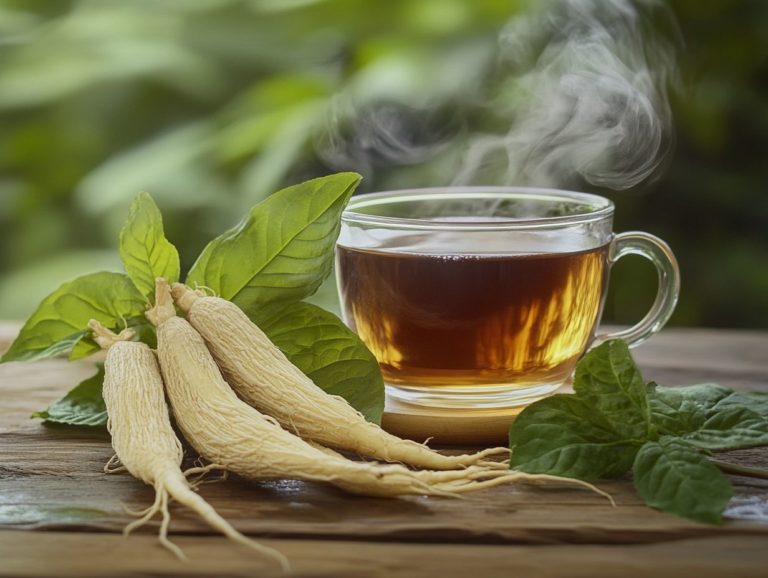5 Common Herbs with Healing Properties
In a world that increasingly embraces natural remedies, you ll find herbs emerging as powerful allies in your journey toward health and wellness. This article delves into five common herbs turmeric, ginger, garlic, chamomile, and echinacea each renowned for its unique healing properties.
Learn how these amazing herbs can help you heal, what potential side effects you should be aware of, and practical strategies for integrating them into your daily routine. Discover their other benefits and whether they re suitable for everyone.
Dive in and unlock the remarkable healing potential of these extraordinary herbs!
Contents
Key Takeaways:

- Turmeric, ginger, garlic, chamomile, and echinacea are 5 common herbs with powerful healing properties.
- These herbs can be used for medicinal purposes in various forms, such as teas, supplements, or topical applications.
- While generally safe for most people, these herbs may have potential side effects and should be used with caution and under the guidance of a healthcare professional.
1. Turmeric
Turmeric is that vibrant yellow spice you might know well. It’s celebrated not just for its color but also for its health benefits. This herb is rich in curcumin, a compound known for its powerful antioxidant properties. It can also help boost your immune system.
Its remarkable anti-inflammatory qualities make turmeric particularly advantageous for anyone dealing with arthritis, offering relief from joint pain and stiffness. For centuries, Ayurveda has used turmeric to support digestion and ease gastrointestinal discomfort.
Recent studies are starting to back up these time-honored claims, revealing a connection between curcumin and positive changes in inflammatory markers across various conditions. This growing body of evidence continues to illuminate how integrating turmeric into your diet can enhance overall well-being and provide natural support for chronic health concerns.
2. Ginger
Ginger is a powerhouse for health benefits. It’s famous for aiding digestion and is a natural remedy for nausea and motion sickness, making it a must-have in many herbal supplements and dietary practices.
Not only is this herb a culinary delight, but it also shines in traditional medicine for its ability to reduce inflammation and enhance overall wellness. With its anti-inflammatory properties, ginger can help alleviate muscle soreness and joint pain, making it a popular choice if you’re dealing with arthritis or other inflammatory conditions.
Scientific studies have revealed that the active compounds in ginger, particularly gingerol, may positively affect blood sugar levels, hinting at potential benefits for managing diabetes. Moreover, ginger has been traditionally used to combat colds and respiratory issues, with research backing its antibacterial and antiviral effects.
This multifaceted herb is increasingly capturing attention in modern wellness practices and clinical studies, solidifying its rightful place in both your kitchen and medicine cabinet.
3. Garlic
Garlic isn t just a cooking staple. It s packed with health benefits for your immune system and cardiovascular health, earning its place as a revered medicinal plant in both traditional and modern herbal medicine.
Packed with allicin a compound celebrated for its antibacterial and anti-inflammatory properties garlic plays a key role in many dietary supplements designed to enhance overall health. Think of garlic as your personal ally in reducing cholesterol levels.
Numerous studies suggest that incorporating it into your diet can lead to significant improvements in your lipid profiles, making it essential for heart health. Many cultures weave garlic into their dishes not only for its unique flavor but also for its therapeutic benefits.
From vibrant Mediterranean meals to zesty Asian stir-fries, people across the globe have recognized garlic’s ability to promote wellness and combat infections. This dual identity as a beloved cooking ingredient and natural remedy underscores why garlic is cherished worldwide.
Start adding these herbs to your meals and experience their healing powers today!
4. Chamomile

Chamomile, especially in the delightful form of chamomile tea, has been treasured for centuries for its calming effects. It is an excellent choice for anyone seeking natural remedies for anxiety and sleep enhancement.
This healing herb is more than just a soothing beverage; it boasts a range of medicinal properties that have attracted attention in both traditional herbal medicine and modern dietary supplements. For those looking for effective solutions, exploring the top 5 DIY herbal remedies for stress relief can be beneficial.
Research indicates that chamomile can effectively alleviate anxiety symptoms. Studies show a significant reduction in anxiety levels among those who regularly consumed chamomile extract. It enhances overall relaxation and contributes to improved sleep quality, making it a perfect addition to your pre-bedtime routine.
Beyond its mental health benefits, chamomile is celebrated for its digestive properties, soothing upset stomachs and alleviating bloating. This illustrates its multifaceted role in promoting holistic well-being.
Traditional herbalists have long relied on chamomile not only for its calming effects but also as a remedy for digestive complaints, underscoring its lasting significance in both ancient and contemporary health practices.
5. Echinacea
Echinacea, often celebrated for its immune-boosting properties, is a vital player in herbal remedies designed to prevent and treat colds and infections. It is a staple in numerous dietary supplements.
This medicinal plant boasts a rich history of traditional uses, particularly among Native American cultures, where it has served as a natural remedy for various ailments.
Recent scientific studies validate many traditional uses of echinacea, revealing that it may not only shorten the duration of colds but also mitigate their severity. Researchers have identified specific compounds within echinacea that stimulate the immune system, prompting a more vigorous response to pathogens.
With its rising popularity, many individuals are now embracing echinacea as a preventive measure during cold and flu seasons, showcasing its potential to enhance wellness.
As your body encounters pathogens, this herbal remedy is believed to bolster your defenses. This makes it an appealing choice for anyone seeking holistic approaches to health.
What Are the Healing Properties of These Herbs?
The healing powers of herbs like turmeric, ginger, garlic, chamomile, and echinacea have been celebrated in cultures around the world, revealing their versatile health benefits from fighting inflammation to bolstering the immune system. These medicinal plants hold a cherished place in traditional medicine and have found their way into modern herbal remedies and dietary supplements.
Take turmeric, for example. It contains curcumin, a compound hailed for its remarkable anti-inflammatory and antioxidant properties, making it a favored option for managing chronic pain and conditions such as arthritis.
Then there’s ginger, recognized for its ability to ease nausea and support digestion. This is due to its active compounds called gingerols, which are responsible for its health benefits.
Garlic also deserves a mention, as it boasts antimicrobial and cardiovascular benefits that can help lower blood pressure and cholesterol levels.
Chamomile, often enjoyed as a soothing tea, is famous for its calming effects, promoting better sleep and aiding digestion.
Meanwhile, echinacea is frequently sought for its immune-boosting abilities, particularly during the cold and flu season.
Scientific studies continue to back up these traditional uses, underscoring their importance as potential complementary therapies in holistic health practices. Embracing these herbs could be a step toward a more natural and balanced approach to your health.
Discover how these herbs can enhance your life today!
How Can These Herbs Be Used for Medicinal Purposes?
Medicinal plants like turmeric, ginger, garlic, chamomile, and echinacea can be embraced in various forms teas, capsules, tinctures, and powders. This allows you to enjoy their health benefits in a way that aligns with your personal preferences and lifestyle. Each of these healing herbs has unique traditional uses that enrich contemporary practices.
For example, you can easily add turmeric to your smoothies or sprinkle it into curries for a flavorful kick. Ginger lends a delightful touch to herbal teas or fresh juices, making your beverages both tasty and beneficial. Garlic shines when enjoyed raw in salads or lightly cooked in savory dishes to retain its potent properties.
Chamomile is well-known for its calming effects. Brew it into a soothing tea before bedtime. Echinacea is popular during cold and flu season to boost your immunity. To fully harness their health benefits, consider proper dosages and honor traditional preparation methods.
Weave these herbs into your meals or self-care rituals regularly.
What Are the Potential Side Effects of Using These Herbs?

While you might know that herbs like turmeric, ginger, garlic, chamomile, and echinacea offer health benefits, it s crucial to watch for potential side effects. This is especially important if you consume them in excess or alongside certain medications. Knowing the safety profiles of these medicinal plants helps you make smart choices when using herbal remedies.
For instance, turmeric could interact with blood thinners, increasing the risk of bleeding. Ginger might lead to gastrointestinal distress or heartburn, particularly if you overdo it. Garlic, despite its heart-health advantages, can increase bleeding risk and cause digestive issues when combined with anticoagulant medications.
Chamomile could trigger allergic reactions in those sensitive to plants in the ragweed family. Lastly, echinacea may prompt allergic responses and interact with immunosuppressive drugs. Thinking about adding these herbs to your routine? Don t forget to consult your healthcare provider, especially if you have underlying health conditions or are on medications.
How Can These Herbs Be Incorporated into Daily Life?
Incorporating healing herbs like turmeric, ginger, garlic, chamomile, and echinacea into your daily routine can be effortless and rewarding. These herbs offer a plethora of health benefits you can enjoy through meals, beverages, and natural supplements. Mastering the art of integrating these powerful herbal remedies enhances your well-being.
For instance, adding turmeric to your morning smoothie or golden milk is a fantastic way to start your day while helping reduce inflammation. Ginger can be brewed into a refreshing tea or grated into stir-fries for a zesty punch. A sprinkle of garlic powder or fresh minced garlic can elevate the flavor of your pasta dishes while supporting your immune health.
Enjoy a soothing cup of chamomile tea before bedtime to help you unwind! Echinacea supplements can be your go-to during cold and flu season. Don t hesitate to experiment with these herbs in salads, marinades, or even baked goods keeping your meals exciting while nourishing your body.
Don t be afraid to get creative! Experiment with these herbs in your cooking and discover delicious, healthy meals!
What Are the Other Benefits of These Herbs?
Beyond their well-known health benefits, herbs such as turmeric, ginger, garlic, chamomile, and echinacea offer a wealth of additional advantages. They not only enhance digestive health but also protect your body from harmful effects, contributing to overall well-being.
These versatile healing herbs are far from one-dimensional; their broader therapeutic properties make them essential players in effective herbal medicine. Take turmeric, for example. It contains curcumin, which has been shown to support brain health and may even improve your memory over time, while also being one of the 5 herbs that support healthy digestion.
Ginger, with its powerful anti-inflammatory properties, doesn t just ease discomfort; it also promotes cardiovascular health by enhancing circulation. Garlic is celebrated for its immune-boosting qualities and is also a champion at regulating cholesterol levels, making it a key ally for heart health.
Chamomile, typically recognized for its calming effects, goes beyond relaxation by helping to reduce anxiety and improve sleep quality. Meanwhile, echinacea is famous for its infection-fighting prowess, contributing to a robust immune system.
By weaving these herbs into your daily routine, you can tap into their extensive health benefits, paving the way for a more balanced and holistic lifestyle! Start incorporating these herbs now to boost your health!
Are These Herbs Safe for Everyone to Use?
While many can safely reap the health benefits of herbs like turmeric, ginger, garlic, chamomile, and echinacea, be careful if you have existing health issues or are taking medications. Understanding the safety profiles of these medicinal plants is essential for ensuring that their integration into your health regimen is both effective and safe.
For example, if you’re on anticoagulant therapies, you might want to steer clear of garlic, as it can amplify blood-thinning effects. Turmeric has the potential to interact with medications that influence liver enzymes, so it’s wise to consult your healthcare provider before incorporating it into your routine.
If you’re pregnant or breastfeeding, it’s equally important to be cautious, as some herbs may lead to adverse effects. High doses of echinacea, in particular, may not be appropriate for those with autoimmune disorders.
Being informed about potential side effects and combining herbs thoughtfully is vital. Ideally, do this under professional guidance so you can enjoy their benefits without encountering unwanted risks.
Frequently Asked Questions

What are 5 common herbs with healing properties?
The 5 common herbs with healing properties are turmeric, ginger, garlic, chamomile, and peppermint.
What is the healing property of turmeric?
Turmeric has anti-inflammatory and antioxidant properties, making it beneficial for treating conditions such as arthritis, indigestion, and skin disorders.
How does ginger help with healing?
Ginger has anti-inflammatory and antibacterial properties, making it useful for relieving nausea, cold and flu symptoms, and digestive issues.
Can garlic really help with healing?
Yes, garlic has numerous healing properties, such as its ability to boost the immune system, lower blood pressure, and improve cardiovascular health.
What makes chamomile a healing herb?
Chamomile is known for its calming and relaxing effects, making it a popular herb for treating anxiety, insomnia, and digestive problems.
How is peppermint beneficial for healing?
Peppermint has antibacterial and antiviral properties, making it effective for relieving headaches, easing muscle pain, and improving digestion.
In summary, these herbs not only offer a multitude of health benefits but also require careful consideration for safe use. Ensure you consult with a healthcare professional where necessary.






